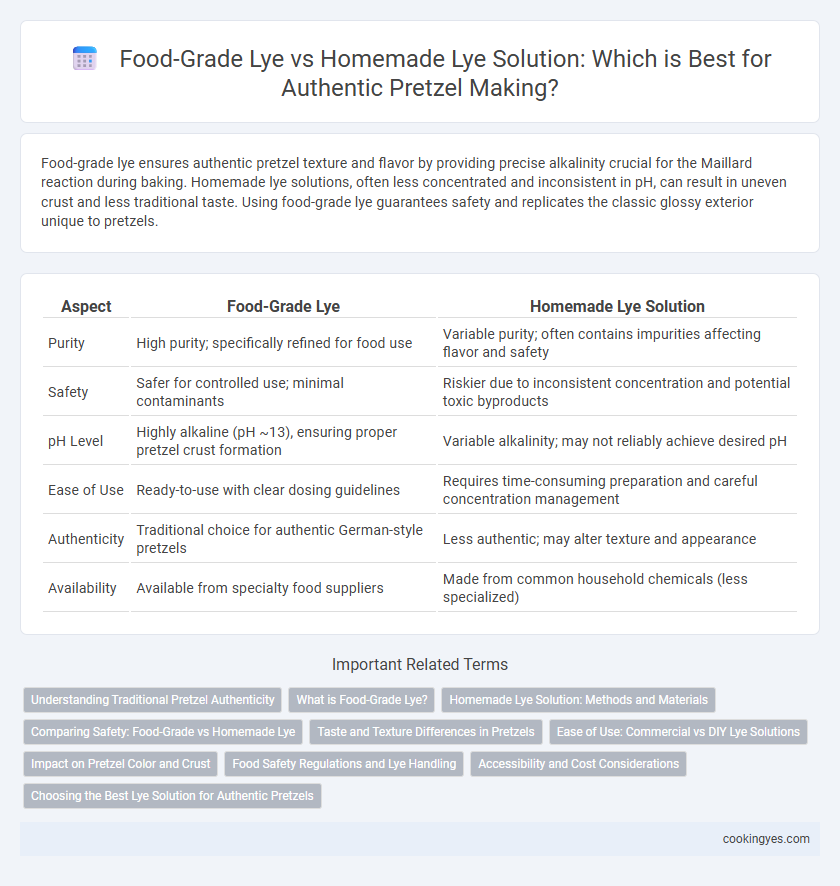Food-grade lye ensures authentic pretzel texture and flavor by providing precise alkalinity crucial for the Maillard reaction during baking. Homemade lye solutions, often less concentrated and inconsistent in pH, can result in uneven crust and less traditional taste. Using food-grade lye guarantees safety and replicates the classic glossy exterior unique to pretzels.
Table of Comparison
| Aspect | Food-Grade Lye | Homemade Lye Solution |
|---|---|---|
| Purity | High purity; specifically refined for food use | Variable purity; often contains impurities affecting flavor and safety |
| Safety | Safer for controlled use; minimal contaminants | Riskier due to inconsistent concentration and potential toxic byproducts |
| pH Level | Highly alkaline (pH ~13), ensuring proper pretzel crust formation | Variable alkalinity; may not reliably achieve desired pH |
| Ease of Use | Ready-to-use with clear dosing guidelines | Requires time-consuming preparation and careful concentration management |
| Authenticity | Traditional choice for authentic German-style pretzels | Less authentic; may alter texture and appearance |
| Availability | Available from specialty food suppliers | Made from common household chemicals (less specialized) |
Understanding Traditional Pretzel Authenticity
Food-grade lye, typically sodium hydroxide, ensures consistent alkalinity and precise pH control essential for achieving the characteristic pretzel crust and Maillard reaction. Homemade lye solutions, often made by dissolving baking soda in water and baking it to increase alkalinity, provide a safer but less potent alternative that may result in variations in texture and flavor authenticity. Using food-grade lye maintains traditional pretzel authenticity by replicating the classic chemical reactions crucial for the distinct glossy surface and deep brown color.
What is Food-Grade Lye?
Food-grade lye, chemically known as sodium hydroxide (NaOH), is a highly purified, food-safe alkali used in pretzel making to achieve the characteristic deep brown crust and distinct flavor. It differs from homemade lye solutions, which may contain impurities and inconsistent concentrations, potentially affecting the pretzel's texture and authentic taste. Using food-grade lye ensures precise pH levels and safety compliance, critical for replicating traditional German-style pretzels.
Homemade Lye Solution: Methods and Materials
Homemade lye solutions for pretzel making typically involve dissolving sodium hydroxide pellets or washing soda in water, offering a more accessible alternative to food-grade lye. The concentration of the homemade solution usually ranges from 1-3%, which helps achieve the traditional pretzel crust without the strong caustic risks associated with undiluted sodium hydroxide. Using baking soda as a substitute creates an alkaline solution but results in less authentic texture and flavor compared to properly prepared homemade lye solutions.
Comparing Safety: Food-Grade vs Homemade Lye
Food-grade lye, specifically sodium hydroxide, is rigorously purified and standardized to meet strict safety regulations for culinary use, ensuring consistent pH levels essential for authentic pretzel crust formation. Homemade lye solutions, often derived from wood ash or other alkaline materials, lack precise concentration control and may contain impurities that pose health risks or result in uneven texture and taste. Using food-grade lye significantly minimizes chemical hazards while providing optimal pretzel flavor, appearance, and safety for consumers.
Taste and Texture Differences in Pretzels
Food-grade lye ensures the authentic pretzel taste by creating the distinct deep brown crust and slightly bitter flavor, which homemade lye solutions often fail to achieve due to inconsistent pH levels. Pretzels treated with food-grade lye develop a characteristic chewy texture and glossy surface, while homemade alternatives can result in uneven browning and a less resilient crust. The precise alkalinity of food-grade lye optimizes Maillard reactions during baking, directly impacting both flavor depth and traditional pretzel texture.
Ease of Use: Commercial vs DIY Lye Solutions
Food-grade lye provides consistent concentration and purity, ensuring reliable results in pretzel preparation with minimal handling risks. Homemade lye solutions, often made by leaching hardwood ashes, require precise measurement and extended preparation time, increasing variability and potential safety hazards. Commercial lye's ease of use and standardized quality make it the preferred choice for authentic pretzels in both home and professional kitchens.
Impact on Pretzel Color and Crust
Food-grade lye produces a distinct deep brown color and glossy crust on pretzels due to its precise alkaline strength, enhancing the Maillard reaction during baking. Homemade lye solutions often vary in concentration, potentially leading to uneven browning and a less authentic crust texture. Consistent pH levels in food-grade lye ensure optimal pretzel coloration and contribute to the traditional chewy yet crispy crust characteristic of authentic pretzels.
Food Safety Regulations and Lye Handling
Food-grade lye ensures strict compliance with food safety regulations, providing a high-purity sodium hydroxide that is safe for direct food contact and prevents contamination in pretzel preparation. Homemade lye solutions may vary in concentration and purity, increasing the risk of inconsistent pretzel quality and potential chemical hazards due to improper handling or impurities. Proper lye handling requires personal protective equipment and adherence to storage protocols to mitigate caustic burns and ensure safe kitchen environments.
Accessibility and Cost Considerations
Food-grade lye, specifically sodium hydroxide with verified purity, ensures consistent pretzel texture and glossy crust but can be costly and harder to access for home cooks. Homemade lye solutions, typically made by dissolving wood ash or baking soda in water, offer an affordable and more accessible alternative but may result in less authentic flavor and texture. Balancing cost and accessibility, many amateur pretzel makers opt for homemade solutions, though professional bakers prioritize food-grade lye for optimal authenticity.
Choosing the Best Lye Solution for Authentic Pretzels
Food-grade lye, specifically sodium hydroxide, ensures consistent pH levels and safety standards essential for producing authentic pretzels with their characteristic glossy crust and deep brown color. Homemade lye solutions, often made by dissolving wood ashes in water, lack precise concentration control, leading to variable results and potential safety risks. Choosing food-grade lye is critical for achieving traditional pretzel texture, flavor, and ensuring food safety compliance.
Food-grade lye vs homemade lye solution for pretzel authenticity Infographic

 cookingyes.com
cookingyes.com